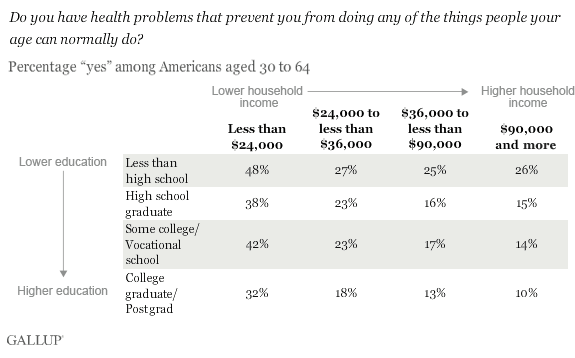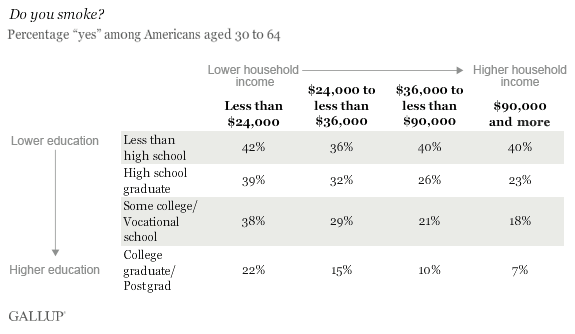WASHINGTON, D.C. -- Advocates of the new healthcare reform law touted it as a way to improve access to insurance coverage and medical care for millions of low-income Americans who are currently uninsured. The eventual result will be an expanded customer base for insurance companies, but the extent to which these new additions represent greater risk for medical claims is yet to be determined. Gallup-Healthways Well-Being Index data reveal that among Americans aged 30 to 64, those with lower household incomes and lower education levels are considerably more likely to say that they have health problems than their counterparts further up the socioeconomic ladder.

These findings are based on an aggregate of 220,000 interviews with Americans aged 30 to 64 based on the Gallup-Healthways Well-Being Index data between April 2009 and March 2010.
Although Americans' education and income levels are highly correlated with each other, the two factors are also independently related to respondents' likelihood to report health problems. Within each income category, those with lower education levels are more likely to say they have problems, and within each education category, those with lower incomes are more likely to do so. The combined effect is sizeable: Those in the lowest education and income category are more than four times as likely as those in the top category for each variable to say they have health problems -- 48% vs. 10%, respectively.
Healthy Behaviors
One reason Americans in the lower socioeconomic categories more commonly report health problems may simply be that they have had less reliable access to healthcare services in the past. For example, 60% of Americans aged 30 to 64 with annual household incomes less than $24,000 say have health insurance, vs. 95% of those with incomes of $36,000 or more.
Once access among low-income Americans improves as the healthcare law is implemented, their likelihood to report health problems may decline to some extent. In terms of comparing the future likelihood of health problems across income and education levels, it's more appropriate to examine specific health-related habits.
A healthy diet and frequent exercise, two key factors in maintaining good health, are just as common among lower income and less educated Americans as among those with higher incomes and more education. Gallup asks Americans how many days in the last week they exercised for 30 minutes or more and how many days they had five or more servings of fruits and vegetables. Those 30 and older at all education and income levels report an average of about 2.5 days with exercise and about 3.5 with healthy amounts of fruits and vegetables.
However, there is one important risk factor that is strongly related to education and income levels: the likelihood to smoke. Researchers have long known that the incidence of smoking is higher among Americans in lower income categories; however, the combined effect of income and education is greater than the relationship between smoking and either variable on its own.

The data reveal a particularly sizeable gap in the likelihood to smoke between those who have and have not graduated from college. Among those in the lowest income category, for example, the percentage of smokers is fairly consistent across all age categories below college graduate, but drops sharply among those who do have a college degree. This finding doesn't necessarily imply that the college experience itself makes Americans less likely to be smokers. College attendance may be a proxy for different aspects of respondents' lives such as different socialization experiences in youth or different types of jobs in adulthood.
Implications
Insurance companies taking on millions of previously uninsured customers over the next few years will invest considerable resources in revising actuarial models to account for the changing demographic makeup of their customer base. Gallup data stress the importance of putting emphasis on smoking cessation programs in managing the risk that customers with lower incomes and less education represent.
Gallup analysts have just begun to explore the association between socioeconomic variables and major health outcomes. Further results on the incidence of common health problems such as colds, flu, headaches, and physical pain can be found in a recent study supervised by Gallup Senior Scientists Arthur Stone and Jim Harter, published in the Archives of Internal Medicine. Such research promises to offer a more nuanced understanding of how targeted health initiatives can improve the well-being of Americans in all walks of life.
Learn more about the Gallup-Healthways Well-Being Index.
Survey Methods
Results are based on telephone interviews with a random sample of more than 220,000 national adults, aged 30 and older, conducted between April 1, 2009, and March 31, 2010, as part of the Gallup-Healthways Well-Being Index. For results based on the total sample of national adults, one can say with 95% confidence that the maximum margin of sampling error is less than ±1 percentage point.
Interviews are conducted with respondents on landline telephones (for respondents with a landline telephone) and cellular phones (for respondents who are cell phone only). In addition to sampling error, question wording and practical difficulties in conducting surveys can introduce error or bias into the findings of public opinion polls.
About the Gallup-Healthways Well-Being Index™
The Gallup-Healthways Well-Being Index measures the daily pulse of U.S. well-being and provides best-in-class solutions for a healthier world. To learn more, please visit well-beingindex.com.
